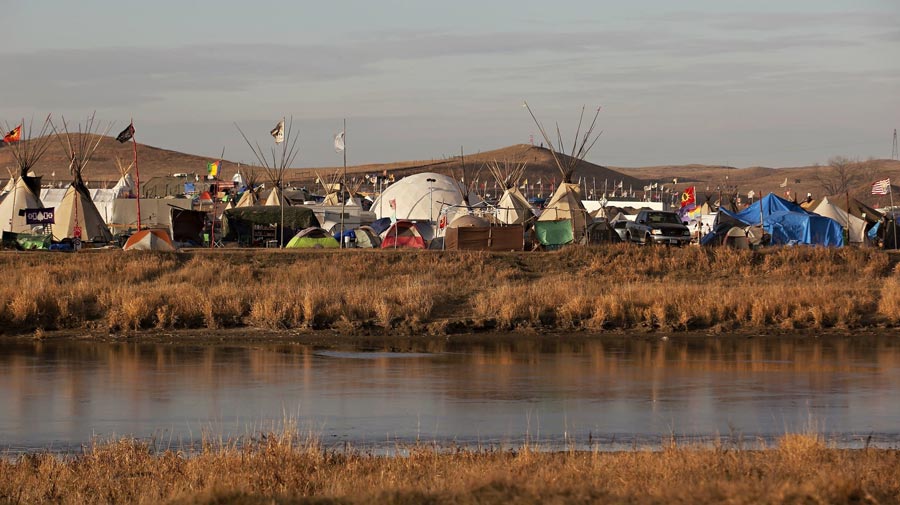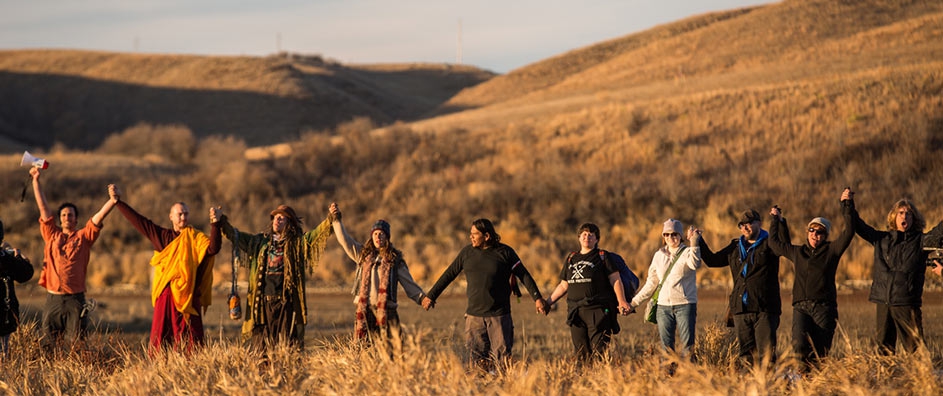The views expressed in our content reflect individual perspectives and do not represent the authoritative views of the Baha'i Faith.
To every meadow be a shower of grace, to every tree the water of life; be as sweet musk to the sense of humankind, and to the ailing be a fresh, restoring breeze. – Abdu’l-Baha, Selections from the Writings of Abdu’l-Baha, p. 244.
If you’ve seen the news coverage of the Dakota Access Pipeline protest encampments, you may not know how amazing the camp is itself.
That’s one of the things I think gets lost in what little media coverage we see—how extensive the camp is. A ceremonial camp, intended to hold a prayerful intention for protecting the sacred waters and standing up to civil rights abuses both present and historical, it now holds thousands of people.
The original camp, Sacred Stone, sits farther east, actually on reservation land. The main camp, Oceti Sakowin—which is the proper name for the people commonly known as the Sioux, and which means Seven Council Fires—houses the peta waken, the sacred fire.
Actually, the term camp doesn’t quite capture what’s happening out there. Once you pull into the main entrance (after smudging with sage), you drive down Flag Avenue, where each indigenous nation and country has posted a flag. As far as I know, this is the largest gathering of indigenous people in American history, and the first time the seven bands of the Oceti Sakowin have gathered since the Greasy Grass Battle in June of 1876.
The losing side in that battle called it Custer’s Last Stand, or the Battle of the Little Big Horn.
Anyway, as you go through camp you can see smaller groupings—the Pueblo camp, the Rosebud camp, the Cheyenne River/Minneconjou, the Standing Rock, the medic camp where you describe your symptoms and from there are directed to the medic yurt, the herbal yurt, or the bodywork yurt. In the center of it all burns the sacred fire, where people come to pray and talk about the day’s events.

Oceti Sakowin Camp
The first thing you really hear when you arrive is all the building. It’s bitter cold here in Cannon Ball, North Dakota, which means everyone is in full winterization mode. Tipis, military tents, and yurts are going up all over the place. Kitchens and mess halls are being extended and insulated. Compostable toilets and green shower stalls are being built. It’s an ever-expanding organic village—if you leave for a couple of days and come back things may have moved and grown.
One thing here really stood out to me, and inspired me with its Baha’i-like spirit: everyone has a role and they’re all valued. For some it’s going to the front for direct action and peaceful protest. But when they come back they need food, a place to warm up, a place to get their wounds treated. People are needed to watch and stoke the sacred and council fires. Everyone works and helps—builders, electricians, people who help set up and winterize tents, capoeira classes, people who power Facebook Hill with a windmill and bicycle to keep the electricity going.
My father-in-law and I were invited to sit by the fire at the women’s camp (invitation only if you’re male). A young guy came over and invited us to his tea yurt. Inside it was warm from an energy efficient stove, cozy with blankets and pillows and good conversation. This guy spends all day building in the camps, and at night he makes and serves delicious tea to anyone, and listens to their stories. An elder in there with us said she would introduce him to the Standing Rock Chairman, because he’s always interested in thanking people who do seemingly little things to make the camp a healing place. That spirit of gratitude and healing reminded me of the Baha’i teachings:
All that has been created is for man who is at the apex of creation and who must be thankful for the divine bestowals, so that through his gratitude he may learn to understand life as a divine benefit. If we hold enmity with life, we are ingrates, for our material and spiritual existence is the outward evidences of the divine mercy. Therefore we must be happy and pass our time in praises, appreciating all things. – Abdu’l-Baha, Divine Philosophy, p. 134.
Just to be clear, I’m not painting this as a utopia. There are issues as there would be with any group of up to 5,000 people, particularly under such stressful circumstances. Even in the tea yurt we could hear a stream of ambulances and the constant low flying planes from DAPL security. But it’s an incredibly special place. Everyone has the same goal, even if some of the tactics are different. In a word, it’s inspiring, and it taught me gratitude.
















Comments
Sign in or create an account
Continue with Googleor